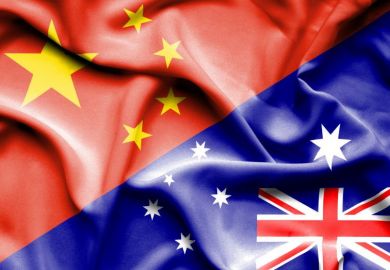Several Australian universities significantly increased their financial dependence on Chinese tuition fees last year amid escalating warnings about the risks of over-reliance on a single source market – warnings followed by renewed bilateral tensions and the Covid-19 pandemic.
The University of Sydney boosted its earnings from Chinese enrolments by about A$150 million (£82 million) to A$796 million last year. Some 30 per cent of the university’s revenue came from the pockets of Chinese students, up from 26 per cent in 2018.
Chinese tuition fees constituted 23 per cent of income at the University of Technology Sydney (UTS), up from 19 per cent in 2018, after revenue from that source rose by A$62 million to A$271 million. UNSW Sydney’s income from Chinese students grew by A$47 million, with their contribution to the bottom line declining marginally to 26 per cent.
The figures – sourced from institutional annual reports and the Audit Office of New South Wales – help to explain why the pandemic has inflicted such financial damage on Australian universities, with a dozen forecasting revenue losses of between A$100 million and A$600 million each this year.
Australian media have been highlighting the dangers of fiscal over-reliance on Chinese students since June 2017. The warnings were echoed in a 2018 report by the Tertiary Education Quality and Standards Agency and in a 2019 analysis by University of Sydney sociologist Salvatore Babones, among many others.
Yet some universities have continued to increase their exposure, led by Sydney, which earned more than A$1 billion from international students last year – 20 per cent more than in 2018.
Sydney’s international education revenue leapfrogged its income from the federal government, whose contribution to the university’s budget declined by almost 3 per cent to A$941 million.
A Sydney spokeswoman said “responsible financial planning” was a university priority. She said the university had a “long-term income diversity strategy” to mitigate concentration risk. It focused on attracting more students from India, South-east Asia, the UK, the US and Canada as well as increasing revenue from research grants, commercialisation, industry partnerships and philanthropy.
“We’ve needed to find other ways to generate income because there has been a significant drop in the share of funding from the federal government since the early 1990s,” the spokeswoman said.
UTS said it aimed to keep the proportion of international students on campus close to 30 per cent, mirroring the proportion of domestic students who went overseas. Deputy vice-chancellor Iain Watt said the target was an “appropriate mix to inject a global perspective in the education experience”, and UTS aimed for the most diversity possible in its international enrolments.
He said UTS was building partnerships with pathway colleges in Sri Lanka, Vietnam, Indonesia and South Korea as well as China itself, to cultivate numbers from different source countries while reducing exposure to factors outside the university’s control.
Australian National University higher education policy analyst Andrew Norton said universities had been forced to find ways to bankroll their own research spending because government grants did not fully cover the costs of research. “But the sheer scale of [universities’] increasing expenditure this century cannot be explained by changes in government policy,” he said.
“There is more to it than that. The inherent desire to do more research, and the pressure that rankings put on them, are very major factors.”
Southern Cross University increased its revenue from Indian students by A$18 million last year to A$39 million, boosting their contribution from 8 per cent to 12 per cent of its income. A spokeswoman said the increase mainly came from master’s of engineering and business administration students.
Register to continue
Why register?
- Registration is free and only takes a moment
- Once registered, you can read 3 articles a month
- Sign up for our newsletter
Subscribe
Or subscribe for unlimited access to:
- Unlimited access to news, views, insights & reviews
- Digital editions
- Digital access to THE’s university and college rankings analysis
Already registered or a current subscriber?












